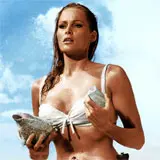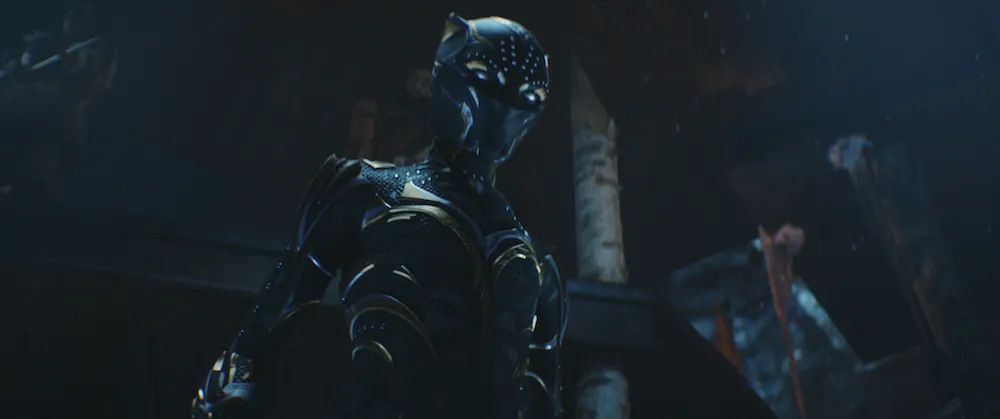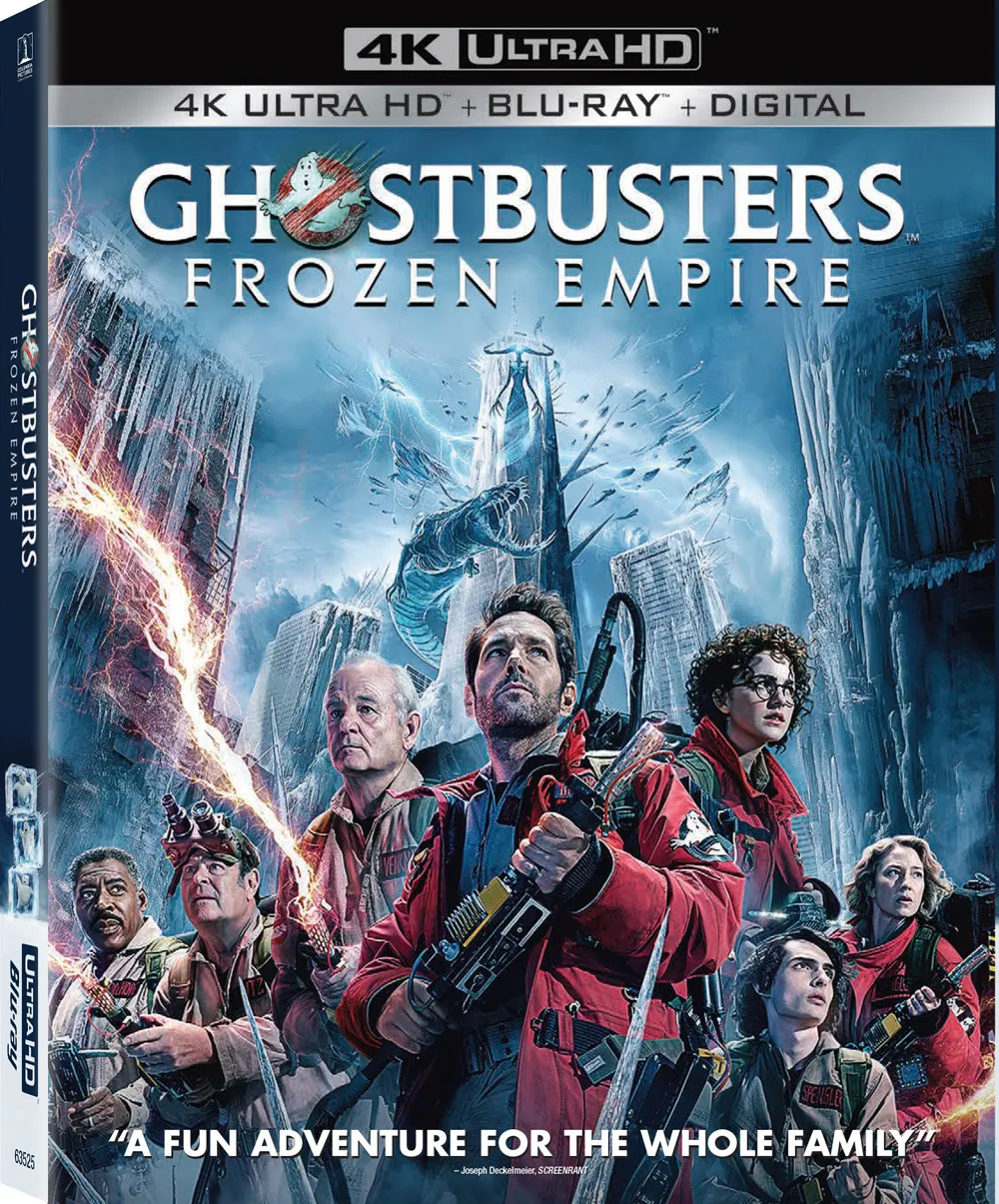 When producers Harry Saltzman and Albert “Cubby” Broccoli set out to create a series of films based off author Ian Fleming’s pulp spy thrillers, I doubt they envisioned the immense success to come. James Bond has become the biggest film franchise behind Star Wars and the longest running cinematic series ever. With the 22nd official Bond film, Quantum of Solace, released in 2008 and six different actors having played the character (seven if you count David Niven in the 1967’s Casino Royale spoof), there looks to be no stopping the franchise as it approaches its 50th anniversary.
When producers Harry Saltzman and Albert “Cubby” Broccoli set out to create a series of films based off author Ian Fleming’s pulp spy thrillers, I doubt they envisioned the immense success to come. James Bond has become the biggest film franchise behind Star Wars and the longest running cinematic series ever. With the 22nd official Bond film, Quantum of Solace, released in 2008 and six different actors having played the character (seven if you count David Niven in the 1967’s Casino Royale spoof), there looks to be no stopping the franchise as it approaches its 50th anniversary.
Dr. No is not the first Bond story published by Fleming but is where the film series got its start. The producers choose it because of a limited budget, not having a proven track record and with a relatively unknown actor in the lead (Sean Connery) determined it was the easiest to shoot. First released in Britain in 1962 and in the United States in 1963, the spy series’ initial outing was a hit, but the real “Bond fever” did not kick in until the follow-up From Russia With Love (1963).
Dr. No has the majority of trappings that would become staples in the later Bond films. James is shown well dressed in his distinctive tuxedo, orders his standard drink (shaken not stirred, of course), travels to exotic locations, drives sporty cars, seduces beautiful and possibly dangerous women (they were not know as “Bond Girls” just yet) and is up against a mastermind criminal set on world domination. We get our first introduction to his classic opening line “Bond, James Bond,” his signature gun (Walther PPK) and standard supporting cast in Miss Moneypenny (Lois Maxwell), M (Bernard Lee) and CIA agent Felix Leiter (Jack Lord). Conspicuously absent is the gadgetry (unless you count the Geiger counter) that would be featured prominently starting with Goldfinger (1964).
There is little point in recounting the plot of Dr. No. Though everyone has their favorite entry in the Bond series, the basic plot structure of each overlaps to the point of making the films fairly homogenous. This is the strength of the franchise allowing fans to follow it for decades through multiple actors and different political/cultural contexts and a major criticism for those who have grown tired of what is seen as useless repetition. If you are only familiar with Bond from his recent cinematic outings, visiting the character’s film origins may range from refreshing to tedious depending on what you expect.
Personally, I consider this one of the better showings in the super spy’s catalog, but its merits will vary depending on how you like your Bond. If you prefer the campier feel of Roger Moore’s 70’s and 80’s work, Dr. No may come off too somber. If the gadgets and hardcore spy thrills are your thing, this may be a bit “low tech” for your tastes. If you are accustomed to the “over the top” action hero Bond has become in recent years, this may seem tame in comparison. Dr. No almost works more as a mystery than a spy thriller, yet at its heart has the signature touches we have come to love about the series. And better yet, now we have it in glorious high definition.
All of the classic Bond films have undergone a thorough frame-by-frame restoration process by Lowry studios with 4k digital scans allowing MGM to provide Dr. No with a full 1080p AVC-encoded transfer. It is framed at the original aspect ratio of 1.66:1, so depending on how you have your television configured to display input with a ratio not as wide as 1.78:1 (the standard for widescreen televisions), you may experience thin black bars “pillarboxing” the image on the left and right. This is normal so do not panic
I was not sure what to expect from Dr. No in high-def with it being 46 years old and shot on a fairly low budget but am overjoyed at the results. From the first of many iconic titles sequences to the memorable scene of Honey Ryder (Ursula Andress as the first Bond Girl) emerging from the Caribbean Ocean, more detail and depth are brought out of the image than I would have thought possible. Lowry’s restoration process has worked miracles removing years of print damage, as there is absolutely none to be found.
Any issue with the high-def presentation for this film resides with the source material and not the process to create the transfer. There is very little to complain about, as I can discern no DNR (the grain structure of the film is pleasantly intact), edge enhancement or digital artifacts. The image is consistently beautiful with many moments where you find yourself astonished at the dimensionality and fine object detail. The Technicolor processed hues jump off the screen with vibrant, deep saturation across the palette.
With some concerted nitpicking, I noticed a few moments where grain was heavy or the image was a bit soft. Contrast is solid but blacks are a bit weaker than what we are accustomed to today. But as I said, I had to try to find fault with the transfer, as it is through and through a superb achievement. Fans of the film have never seen it look this good, and I will even wager this looks better than the theatrical exhibition.
Unfortunately the audio has not weathered the years as well as the visuals. Dr. No, like many of the early Bond films, had a monaural soundtrack. That is for the most part reproduced here though as 2-channel stereo like many of MGM/Fox’s “mono” audio offerings. There is also a DTS-HD Master Audio 5.1 mix that has its merits and deficits. To their benefit, both tracks present dialog and Monty Norman’s memorable theme music clearly and with distinction.
The immediate benefit of the lossless track is being mastered with a much higher bitrate (3.0 Mbps average) than the paltry 224 Kbps we get with the mono recording. It also opens up the soundstage giving a wider presence to the audio, though it is not as enveloping as many modern soundtracks. However, purists will want to stick with the mono mix, as it is more balanced throughout though seems a bit flat compared to the lossless audio.
The problems come from the way the surround mix was constructed. While a good bit of the lossless audio still emanates from the front channels, there are moments where the rears are used which seem gimmicky. A good surround mix will have effects coming from different directions that blend seamlessly with the onscreen action. In this case, the particular sound elements repurposed for the surround mix seem forced and disjointed.
Both tracks suffer from instances where the limitations of the original recording come through. The upper register can slightly distort at times, and action scenes such as the explosion at Dr. No’s facility do not pack as much of a punch as would be hoped. Overall the audio is decent but does not impress anywhere near the level of the high-def visuals. There is also Spanish mono (2.0 channel) and French 5.1 Dolby audio. Subtitles are provided in English (SDH) and Spanish.
All the extras from the previous DVD editions look to have been ported over with two of the better ones having been mastered in high-def though many of the others have substandard video quality with much distracting print damage and blurry graphics. There are a good number of extras here, but I think this may be a case where quantity overrides quality. The commentary has its moments but can be tedious; the main documentary is easily the most interesting special feature though the background on the restoration process for the films is also fairly intriguing. A lot of the promotional pieces are of very poor video quality and grow tiresome quickly.
One major deficit to the special features is the decision to be “cute” with the naming of the menu options. Rather than “Play Movie” and “Chapter Selection,” we get “Initiate Mission” and “Mission Selection.” These options are fairly easy to figure out but once you get into the Special Features menu, it can be confusing at first. The extras are broken up vaguely by theme, and each section can have subsections.
The problem is the name of each section for the extras seems somewhat random and does not give you any specific idea as what to expect. “Top Level Access” contains the single extra on the restoration of the films while “007 Mission Control” contains links to scenes in the movie and “Mission Dossier” has the main documentary and a promotional feature. If they had dropped these confusing names, it would have made the features much easier to navigate.
The extras are listed below with the top-level name of each section followed by details and/or subsections following.
Audio Commentary – A feature-length commentary hosted by John Cork of the Ian Fleming foundation. It is constructed of interviews from the director, editor, composer, production designer, set designer, publicity director and other members of the crew along with many of the supporting cast including Lois Maxwell and Ursula Andress.
None of the interviews appear to have been done at the same time and are edited together with Cork giving a quick introduction as to who is about to speak. The commentary is a mixed bag with some very interesting tidbits and some really tedious moments where I found myself just watching the beautiful transfer and losing track of who was speaking.
The context of which the interviews are being used changes often, and it can be tedious to follow exactly who is speaking and about what. Part of the problem is that within a single scene, several different interviews will be used though only one person speaks at any given moment. Sometimes the interview will be surprisingly in synch with what is on screen providing interesting background information. Other times, someone will be talking about history of the film that has no relation to onscreen events. It would have been nice if there was a way to give a visual cue as to who was speaking at any particular point.
An additional problem (at least for me) is that the commentary is played over the audio for the film, which goes on in the background. This can make the commentary hard to distinguish from the soundtrack at points. If you are a big fan of Dr. No, it is worth giving a listen as there are many moments where it works, but this is by no means an exemplary example of how to “construct” an audio commentary.
Top Level Access Section
License To Restore (11:56) – An interesting featurette on studio Lowry Digital Images work to restore all the Bond films and make high-def transfers with 4000 resolution digital scans. Snippets of interviews from Fox/MGM executives and the CEO, artists, color scientists and project managers at Lowry are included.
They detail the efforts to cleanup the original print negatives including frame-by-frame restoration at four seconds per frame which required around 100 hours of work for one hour of footage. They also make an interesting distinction between cleaning (removing print damage) and improving (digitally altering the image to correct film mistakes). The video quality is not that great, and it may be slightly ironic that this is only presented in standard definition.
Declassified-MI6 Vault Section
Guns of James Bond (5:06) – Promotional black and white video with introduction by Sean Connery. This consists of gun expert Jethrey Bullthrough giving an overview of the main guns used in the movie, the Beretta and Walther PPK.
Premiere Bond: Opening Nights (13:09) – An overview of the opening night events for all Bond films from Dr. No through the Brosnan flicks. The narration is very stilted, and it feels rushed and repetitive. However, you do get to see British royalty (Queen Elizabeth, Prince Phillip, Princess Anne, Prince Charles) and many stars attending the gala openings for the films, which became cultural events.
007 Mission Control Section
A collection of direct links to the movie (with the exception of the opening title gun shot without text). They are broken down into popular themes such as women, locations, etc. Each section has three or so choices with an option to play all. This is not very well designed as you spend as much time clicking the menu as actually watching. If they had made a montage of popular moments from the film, it would have worked much better. This is not worth your time.
Mission Dossier Section
Inside Dr. No (42:10, HD) – This 42-minute documentary is easily the meatiest special feature and has been mastered in HD for Blu-ray. Considering how much of the era specific footage in the other extras looks so poor, this is a pleasant surprise. It does not match the quality of the film but does not constantly distract you with print damage like the standard definition extras.
This feature covers the making of Dr. No and the generation of the Bond franchise. It details Saltzman and Broccoli’s efforts to get the film series off the ground plus director Terence Young’s influence on the style of the character. Casting background is given for many of the reoccurring characters and the first villain plus interesting details around deciding on Connery as a relatively unknown actor to be the lead.
There is input from David Picker (former CEO of United Artists) and editor Peter Hunt along with the sound designer, production designer and location manager. Interesting details are given on how the “Bond” style came together and the filming of the famous scene of Ursula Andress coming out of the ocean. This is a “must watch” for fans of Dr. No.
Terence Young: Bond Vivant (17:57, HD) – This is the other extra that has been mastered in HD for the Blu-ray release. It goes into the background of how director Terrence Young helped form the style that we associate originally with Connery’s portrayal and ultimately the later actor’s takes on Bond. Apparently the director was very sophisticated and had impeccable tastes that he carried over into the lead character’s portrayal.
There is some overlap with the main “Inside Dr. No” feature but includes additional material including input from Lois Maxwell (Miss Moneypenny), Desmond Lleewelyn (Q), Ursula Andress (Honey Ryder), Young’s daughter and the stuntman, editor and production designer on the film.
Dr. No 1963 Featurette (8:40) – Promotional feature created around the time of the film’s theatrical release. Its high points talk about Connery as Bond, the choice of actor to play M, the various guns used in the film plus the adaptation of Fleming’s novel.
Ministry of Propaganda Section
TV, Movie and Radio promo pieces. Following the trend for the promotional extras, video quality is fairly poor. There is an option to play all on both the video and radio pieces.
Theatrical Archive (10:57, partial HD) – The theatrical trailer (mastered in HD) and three other promotional pieces shown before movies to advertise the re-release of several Bond films.
TV Broadcasts (1:23,) – Two short television promos with Honey Ryder and Pussy Galore as the theme.
Radio Communications (6:38) – Six radio spots used to advertise Dr. No.
Image Database Section
A large collection of black and white pictures. Each section is given a text introduction for context and they cover actors, Fleming visiting the set, shooting in Pinewood and Jamaica, the filmmakers, the lost scene with Honey Ryder being terrorized by crabs and posters/marketing for the film around the world. They are interesting but unfortunately fairly small. An option to play all is not given which would have been nice.
With MGM’s first wave of Bond films (including From Russia With Love, Thunderball, Live and Let Die, For Your Eyes Only and Die Another Day), the Blu-ray format is being graced with some classic catalog titles. Dr.No is among that first set with a hypnotic 1080p transfer. All the extras, though some of questionable quality, from the DVD versions are included, and we get the original mono sound mix along with new 5.1 lossless audio.
Bond fans should be delighted at having this abiding start to the super spy franchise in its best presentation ever. If you have never seen where James Bond got his start in cinema, there is no better way to discover it. Now, I cannot wait to see Goldfinger on Blu-ray.
– Robert Searle


